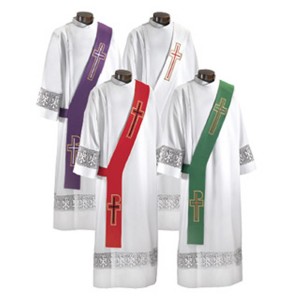
By editor - 01 June, 2014
 The 2013-2014 annual survey of permanent deacons in the United States finds the majority are married Caucasians, and the number at retirement age is on the increase. The survey also finds that U.S. permanent deacons reflect a greater ethnic mix than U.S. priests in general but less of a mix than the general Catholic population.
The 2013-2014 annual survey of permanent deacons in the United States finds the majority are married Caucasians, and the number at retirement age is on the increase. The survey also finds that U.S. permanent deacons reflect a greater ethnic mix than U.S. priests in general but less of a mix than the general Catholic population.
The findings are outlined in “A Portrait of the Permanent Diaconate: A Study for the U.S. Conference of Catholic Bishops 2013-2014.” The study was conducted by the Georgetown University-based Center for Applied Research in the Apostolate.
“Ever since their inception into the modern church in the 1960’s, permanent deacons have served generously in our parishes, institutions and communities and remain special gifts to the Church,” said Bishop Michael F. Burbidge, chairman of the Committee on Clergy, Consecrated Life and Vocations.
“As their median age increases, we must take necessary steps to invite others to hear the Lord’s call to serve as deacons.”
Major findings from arch/dioceses that responded to the survey note the following:
• Chicago, with 745 permanent deacons, has the most permanent deacons, followed by Galveston-Houston (418), Los Angeles (407) and Philadelphia (336).
• The Los Angeles Archdiocese has more than 10,000 Catholics per deacon. Other arch/dioceses with high numbers of Catholics per deacon include El Paso, with more than 26,500 Catholics per deacon, Fresno and San Jose in California, with more than 16,000 Catholics per deacon, and San Bernardino with more than 14,000.
• On average, responding arch/dioceses and arch/eparchies report 84 deacons in active ministry.
• Ninety-three percent of active deacons are currently married. Four percent are widowers, and two percent have never been married. Less than one percent are divorced or remarried.
• Ninety-four percent of active deacons are at least 50. About a quarter (24 percent) are in their 50s, four in ten (42 percent) are in their 60s, and more than a quarter (28 percent) are 70 or older.
• Dioceses have mandatory ages of retirement from active ministry for deacons. Twelve percent require retirement at age 70; 85 percent at 75, and three percent at another age.
• Active permanent deacons are more diverse racially and ethnically than U.S. priests, although not as diverse as the U.S. Catholic population.
• Six in ten active deacons (60 percent) have at least a college degree. More than one tenth (11 percent) have a graduate degree in a field related to religion or ministry.
• Eighty-three percent of responding arch/dioceses require post-ordination formation of deacons, with an average of 20 hours of post-ordination formation annually.
• Nearly three in ten (28 percent) active deacons have a graduate degree. Almost twice as many have a graduate degree in a field not related to the Diaconate (17 percent) as have one in a religious field such as religious studies, theology, Canon Law, etc., (11 percent).
• One third (32 percent) of active permanent deacons have a bachelor’s degree as their highest level of education. About one in five (18 percent) has some college education or an associate’s degree as their highest level of education. One fifth (20 percent) have a high school degree or GED. Very few active deacons (1 percent) have less than a high school degree.
• During the 2013 calendar year, responding arch/dioceses reported 355 deacons retired from active ministry and 237 died. In 2013, 19 deacons requested laicization.
• Twelve permanent deacons were reported to have left the diaconate to prepare for the priesthood.
• About one in six (16 percent) active permanent deacons are financially compensated for ministry. Deacons compensated for another parish ministerial position (in addition to their diaconal responsibilities) make up the largest proportion among those compensated for their ministry.